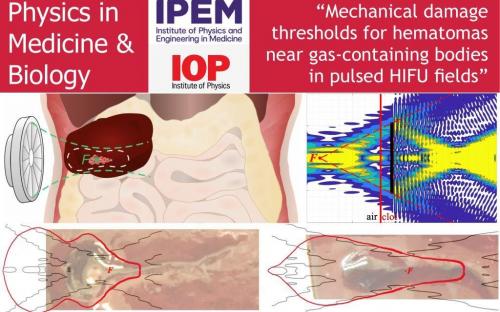Our paper on safety thresholds for liquefaction of large hematomas by boiling histotripsy near gas-containing bodies was published in Physics in Medicine and Biology journal (Q1)
A paper titled «Mechanical damage thresholds for hematomas near gas-containing bodies in pulsed HIFU fields» was published in a top-rated Physics in Medicine and Biology journal (Q1, IF 4.174) by a LIMU graduate student E.M. Ponomarchuk and LIMU research fellows O.A. Sapozhnikov, P.V. Yuldashev and V.A. Khokhlova together with our colleagues from the University of Washington.
The paper presents the results of a study investigating safety of non-invasive liquefaction of large hematomas by boiling histotripsy for gas-containing bodies (such as lungs, intestines, etc.) typically adjacent to hematomas occurring in human body.
In the study, the results of multiple experiments carried out using three ultrasound transducers with different focusing angles were correlated with non-linear focused ultrasound fields numerically calculated in HIFU-beam simulator. This allowed to determine the pressure thresholds damaging the hematoma-air interface, as well as to outline the safety boundaries around the beam focus, based on the incident ultrasound field, outside of which a gas-containing organ would not be mechanically damaged during non-invasive liquefaction of adjacent hematomas.
Moreover, since hematoma material is much easily damaged by histotripsy than all other soft tissues and gas-containing bodies are typically enclosed into a capsule, the determined safety boundaries can be applied not only for hematoma liquefaction but also in histotripsy applications for other soft tissues adjacent to gas-containing bodies.
Overall, in clinical implementation of boiling histotripsy, the determined pressure-based safety boundaries can be predicted based on the induced ultrasound field structure and superimposed onto in-treatment ultrasound image for treatment planning and monitoring to avoid damage to adjacent gas-containing bodies.




